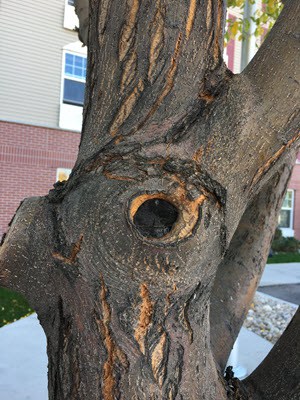You have decide to straighten up the yard a bit by pruning trees and shrubs. You have all your gear gathered and you are ready to go. Then you have a thought. . .
Is tree pruning sealer necessary? No, today’s latest research has shown that by applying a sealer after you prune a plant can actually provide a great protective place for insects and disease. As well as, impeding the healing process altogether.
The late Dr. Alex Shigo of the U.S. Forest Service Laboratory in Durham, findings resulted in a huge shift in thinking by arborists and foresters. From how to properly trim a branch to whether using pruning sealer was positive or negative.
After all his research it was determined that using a pruning sealer was not beneficial to the healing process of the plant and in fact, usually would have the opposite effect. But there are exceptions to every rule. . .
How Does a Tree Heal Itself?

Unlike animals that heal themselves, tree actually don’t heal themselves. But rather “grow over” the wound or cut area. This growth encapsulates the cut or wound and isolates it from the rest of the good healthy wood.
If you take a look at a tree that was either pruned or injured a few years ago you will notice that you can still see the old cut but the tree is growing over the top of it with new growth.
The natural process of the tree is for the sap to cover the area to temporarily protect the tree from insects and rot. Then it will start the process of growing wood over the cut like a callus to permanently seal off that area and continue to grow for many years to come.
If the tree suffered storm or wind damage then you may need to make a cleaner cut to make it easier for the tree to cover over the area. Just remember to make your cut just before the “collar” next to the trunk or if you are cutting off part of a damaged branch then make your cut just before a fork or branch on the limb.
If you leave a stub it will take much longer for the tree to grow over the area. The stub will have to completely rot and fall off in order for the tree to grow over it. This process can take years and you will have to look at the ugly stub during this time.
How To Prevent Oak Wilt When Pruning
There is an exception to every rule and with pruning sealers, it is no different. The oak species of trees ( genus Quercus ) heals in the same way as all other trees, but there is a disease that is spread from insects landing on fresh open cuts – Oak Wilt.
Oak wilt is spread by 2 methods:
Method 1 – Oak wilt which is a fungus, spreads in the ground through the root system of oak trees.
Method 2 – Oak wilt is spread by sap beetles that fly from tree to tree with the fungus on them. These beetles are attracted to the sap of a freshly cut or injured oak trees.
If you can just protect the fresh cut for 7 – 10 days, the oak tree itself will have had a chance to heal itself, so that it can defend the area.
You can also contact your local Agricultural Extension Service to see if Oak Wilt is even an issue in your area. Simply Google the term “Agricultural Extension Service” and a list of the closest ones will appear.
Most are tied to a local University and have free information because they are funded through land grants.
Immediately after pruning a member of the oak family you should seal the area. Now, this brings us back to pruning sealers.
What Do You Put On a Tree Wound?
If you are pruning oak trees then it is advised to use a pruning sealer immediately after pruning. There are several products that can be used to seal the area. Keep in mind that the sealer really only has to last about 10 days. Just long enough for the oak tree to heal itself and not have the fresh sap that the beetles are looking for.
- Asphalt Sealers – Asphalt sealers are what most people remember seeing from when they were a child. It is an oil based sealer that looks and smells like road tar. While this stuff will seal the wound long enough to prevent the sap from running out of the tree which attracts the sap beetles, it does not help the tree because it is an oil-based product and do you think that helps a wound heal?
- Latex Sealers – Today we have alternatives to the old school oil-based sealers. Latex sealers can accomplish the goal of the sealing the sap and repelling the insects until the oak tree has healed itself.
- Organic Natural Tree Sealers – are another option to consider. Remember the goal is the be able to seal the fresh cut area for at least 10 days. There are several products today that fit the bill.
- Homemade Tree Pruning Sealers – I’m sure if you Google homemade pruning sealers you will see many different recipes and applications, but there are no tests that can confirm that they work well, so you are applying at your our risk. If it provides the tree with the complete seal for the timeframe needed, it will probably prevent the attraction of the sap beetles that spread the Oak Wilt disease.
- Household Paints as sealers – In a pinch, this can be used but it is not recommended. The issue is that paints are not designed to be used for live wood healing and will not allow the tree’s natural process to properly take place.
Pruning Sealer Alternatives – Which Have Proven To Be Better
Studies by many Universities, Agricultural Extension Services, and Forestry Services have proven that rather than worrying about what sealer to use or whether to use any at all, it is far better to prune the correct way.
If you prune using proper techniques it will allow the tree or shrub to actually heal faster. Providing the best situation for the natural ability of the sap to do its job to keep out pests. And for the plant to grow over the exposed area as quickly as possible.
For tree limbs that you prune at the trunk you will want to make the cut right before the “collar” that comes off the trunk and starts the limb.
If you are pruning a branch tip they you will want to make your cut right by a fork or other branch at a slight angle so that water doesn’t sit.
For shrubs, you will want to make your cuts close to a fork in the stem. Or if it has multiple stems coming up out of the ground then you will want to make the cut as close to the ground as possible with a slight angle ( up to 45 degrees) so that water doesn’t sit on the cut end.
Related Questions
What Do You Put On a Tree Wound? Nothing. Make sure that the wound area is clean from debris and has a clean edge which will promote faster healing by the tree. Depending on how ripped or tore the bark is around the wounded area, you might have to take a sharp knife or saw to make a clean edge around the wounded area. Sealers are not necessary at all. Let the tree do its thing naturally.
Does cutting off dead branches help a tree? Yes, it takes time for a limb to naturally rot enough to fall off the tree and during that time you are inviting disease and rot to get into the tree’s healthy tissue. By making a nice clean cut you will help the tree to grow over the area faster.
Do branches grow back after pruning? No, the branch will not grow back if properly pruned. The tree will grow over the cut area to seal it off from diseases and rot. If it is not properly pruned then there is a slight chance that it will try to sprout new growth by the cut area.
